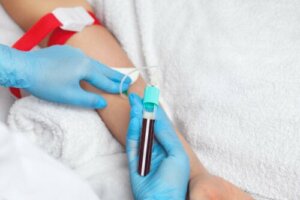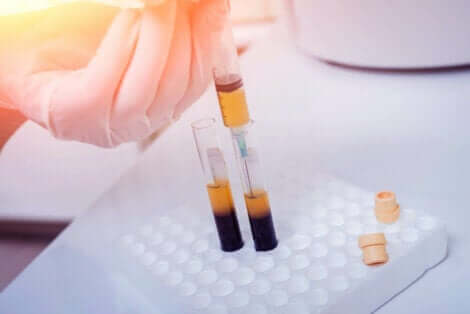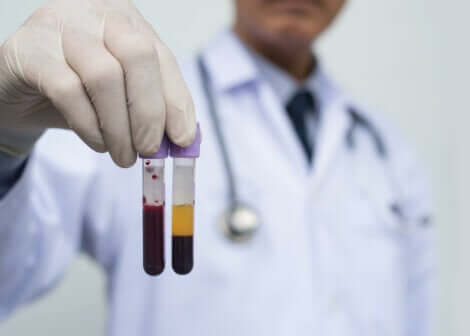What Are Plasma Transfusions?


Written and verified by the doctor Leonardo Biolatto
Plasma transfusions have become very popular in recent years. What is plasma? It’s the clear, slightly yellowish liquid that doesn’t contain blood cells.
Plasma is almost 55% of the total volume of our blood. The other part is made up of cells like red blood cells, white blood cells and platelets. In this liquid there are many proteins, like albumin, which perform very important functions in the body.
Although many people don’t realize, plasma transfusions can treat many pathologies, like bleeding or burns. In this article, we want to explain what this procedure consists of and why it’s so important to donate blood.
What is blood plasma?

As we’ve already mentioned, plasma is the liquid part of the blood, which combines with the blood cells, both red and white, and the platelets. When the two parts are separated, the plasma looks like a transparent liquid.
Plasma is almost 90% water. However, the rest of its composition is a mixture of proteins and mineral salts that are essential for the body to function properly.
First, it contains immunoglobulins, which are the part of the immune system that helps protect you against infections. In addition, there’s also albumin, which is a molecule that’s responsible for transporting certain substances to the tissues.
In the same way, it’s important to note that plasma also contains coagulation factors. This is what helps the blood to start to clot when there’s a hemorrhage somewhere in the body.
You might also like: Do You Need to Raise Your Platelet Count? These 4 Remedies Can Help
How do plasma transfusions work?
Plasma transfusions are actually very simple procedures. First, there needs to be a donor. If you want to donate, it needs to be an altruistic and selfless act. Here, the nurse will extract the blood from the donor, with the process usually lasting between 30 and 45 minutes.
After the blood is drawn, the blood cells are separated from the plasma. Then, they preserve and store the liquid. When it comes to plasma-only donations, it’s called plasmapheresis.
The latter differs from donating blood in that the extracted cells are reintroduced, and they only keep the plasma. In addition, the recovery is shorter and you can donate every fifteen days.
Also, it’s important to note that to perform a plasma donation, the donor and the recipient must have the same blood type. This is because, in plasma, there are proteins that could cause the body to reject the donated blood.
Check this out: High Levels of Monocytes in the Blood: Symptoms and Treatments
What is it for?

There are many reasons for doctors to perform a plasma transfusion. For example, when someone has suffered burns or a serious accident, plasma transfusion helps the blood to regain lost volume.
In addition, since plasma has clotting factors, this technique makes it possible to stop bleeding more quickly. In fact, it’s especially useful in people who suffer from diseases like hemophilia, caused by the lack of any of these factors.
Also, it’s used in liver transplants. However, techniques have been developed in which, instead of introducing all the plasma, they only use the molecules they need. They are called blood products.
For example, for someone with hemophilia, the clotting factor that the person needs can already be transfused. Although plasma transfusion is a safe technique, it has more drawbacks than if you only transfer blood products.
What we need to keep in mind is that plasma transfusions are simple procedures that can save many lives. Therefore, it’s important that we’re all aware that by making a simple donation, we can help many people.
All cited sources were thoroughly reviewed by our team to ensure their quality, reliability, currency, and validity. The bibliography of this article was considered reliable and of academic or scientific accuracy.
- Estrategias de transfusión de plasma para pacientes graves | Cochrane. (n.d.). Retrieved May 5, 2020, from https://www.cochrane.org/es/CD010654/INJ_estrategias-de-transfusion-de-plasma-para-pacientes-graves
- Indicaciones para la transfusión | Centro Regional de Transfusión Sanguínea de Granada y Almería. (n.d.). Retrieved May 5, 2020, from http://transfusion.granada-almeria.org/actividad/indicaciones-para-la-transfusion
- ¿Para qué se utiliza el plasma? | Banco de Sangre. (n.d.). Retrieved May 5, 2020, from https://www.donarsang.gencat.cat/es/donacion-plasma/para-que-se-utiliza/
- Isabel Laura Campano-Pérez. (2018). Utilización del recambio plasmático como herramienta terapéutica en la práctica clínica. FARMACIA HOSPITALARIA, 1, 16–19. https://doi.org/10.7399/fh.10845
This text is provided for informational purposes only and does not replace consultation with a professional. If in doubt, consult your specialist.








